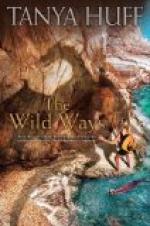All of them were on thorns—though on reeds, really—and evidently highly rattled and in a state of nerves over the trouble in the reeds. And not much wonder either, for, judging by the sounds, murder was being done in there among the secret recesses of the swishing green stems—murder cruel and violent, in spite of the sunshine and the light of day.
And then, all of a sudden, in the midst of almost a gasp of silent horror, a moment of speechlessness on the part of the wild lookers-on, out came the trouble, rolling over and over and over upon the soft, short-cropped grass of the dike-bank, and—they all saw. Also, they all, except the little warblers, who were safe, more or less, and stayed to blaspheme the public nuisance, instantly and at the same moment remembered appointments elsewhere, and went to keep them with a haste that was noticeable and wonderful.
There before them was a hare. But a hare is a gentle and altogether negligible wild-person. This hare, however, was fighting, and fighting like several furies, and grunting, and making all sorts of unharelike motions and commotions against another beast; and that other beast was most emphatically not a hare.
It—or, rather, he—was big, as we count bigness among four-footed wild-folk in Britain to-day. Probably he could stretch the tape to twenty-three inches, of which about sixteen consisted of very long, low body, with sturdy, bear-like, dumpy legs, the rest being rather thick, furry tail; and, though nobody—without steel armor—might have cared to take on the job of weighing him alive, he would have turned the scale at about two pounds eight ounces, or perhaps a bit more. Not a big beast, you will say; but in the wild he ruled big, being snaky and of a fighting turn, so to say. He was, in fact, the very devil, and he looked it—hard as nickel-steel. A dull, tawny devil, with a peculiar purplish sheen in some lights—due to the longer hair—on his short, hard coat, turning black on his throat, legs, and tail—as if he had walked in black somewhere—and finished off with patches of creamy white on head and ears. There was an extraordinary air of hard, tough, cool, cruel, fighting-power and slow ferocity about the beast—a very natural born gladiator of the wild places.
Men called him polecat, apropos of nothing about him, apparently, for he had no connection with poles or cats; or foumart, apropos—and you wouldn’t have needed to be told if you had got to leeward of him just then—of his very unroselike smell—that is, fou—foul, mart—marten, his nearest relation; or, again, fitchett, as our forefathers termed him.
But never mind. What’s in a name, anyway? A big sloe-hare, with a leveret or two not for sale—and that doe’s leverets must have been in the rushes somewhere—may, upon occasion, show unexpected fighting-powers. And this one did. The polecat was kicked in the stomach, and kicked and scratched in the ribs, and thumped on the nose, and kicked and scratched and thumped on the head, before he could get in the death-stroke, the terrible lightning-thrust at the brain’s base, which, like the sword-stroke that ends the bull-fight, dropped the victim as if struck by electricity.




